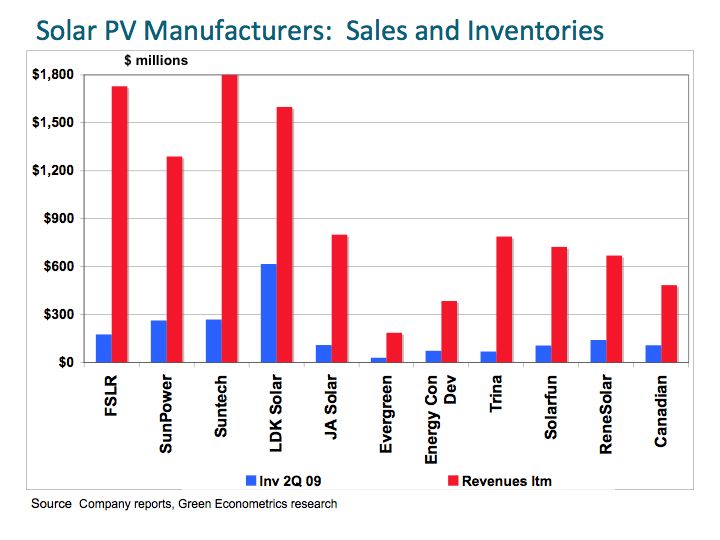Falling Panel Prices could bring Solar closer to Grid Parity
Rising inventory levels of photovoltaic (PV) panels and new production capacity coming online is driving solar PV prices lower and thereby, bringing solar energy closer to grid price parity. With the release of the latest earnings of solar energy companies, Wall Street’s keen attention to revenue guidance, inventory levels and pricing are paramount in diagnosing the health of the solar energy industry. Expectations call consolidation of the solar industry with some key players gaining market share and for others it becomes more challenging. However, despite the turbulence in the industry, consumers will benefit in the near-term as solar PV prices fall and government incentive fuel growth in solar PV deployment.
To get a better perspective on the solar PV industry, let’s examine inventory levels for some of the leading solar PV suppliers. The following chart, Figure 1, compares inventory levels in relationship to sales volume. While inventory levels have increased, the level of inventories to sales is not egregious
Figure 1 Sales and Inventory levels 
While it is important to control inventory levels in relationship to sales, revenue growth is predicated upon price, performance, and return on investment for prospective customers. Thin-film PV has emerged as the low-cost solar solution even with its lower efficiency levels in comparison to mono-and poly-crystalline PV panels. Thin-film still offers a lower cost/watt than crystalline PV, see Solar Shootout in the San Joaquin Valley , but prices for crystalline PV are falling as a result of rising production capacity and inventory levels.
Figure 2 Market Value 
In Figure 2 Green Econometrics is comparing the market value of some of the leading PV suppliers as measured by their respective stock prices. In the valuation of solar PV suppliers, the stock market appears to be betting heavily on thin-film PV, as First Solar (FSLR), the leading thin-film PV supplier, enjoys a market value that accounts for over half the value of the entire solar industry. FSLR is positioned as the low-cost supplier in the solar industry with its announcement of $1 per Watt reducing its production cost for solar modules to 98 cents per watt, thereby braking the $1 per watt price barrier. However, new panel suppliers, mainly from China are pushing prices lower for poly-and mono-crystalline panels suppliers. ReneSolar (SOL) is seeing average selling prices for wafers at $0.93 per watt and bring PV panels prices to under $2.00 per watt.
There appears to be a lot riding on the success of thin-film PV and as prices fall for crystalline PV, the closer we get to grid parity. In the following chart, Figure 3, price for crystalline PV have declined quite dramatically in the last 30 years. According to the Energy Information Administration, in 1956 solar PV panels were $300 per watt, and in 1980, the average cost per solar modules was $27/watt and has fallen precipitously to approximately $2/watt in October 2009. As the installed cost of solar PV falls closer to $4/watt, pricing per kilowatt-hour (KWH) (depending on your climate and geography), equates to approximately $0.16/KWH that would be inline with utility rates after rates caps are removed.
Figure 3 Solar PV Prices 
The bottom line is that despite the lower PV panel costs; we are still not at parity with hydrocarbon fuels such as coal and oil. Carbon based taxes or renewable energy incentives as well as more investment into alternative energy should improve the economics of solar and wind and bring us to grid parity.